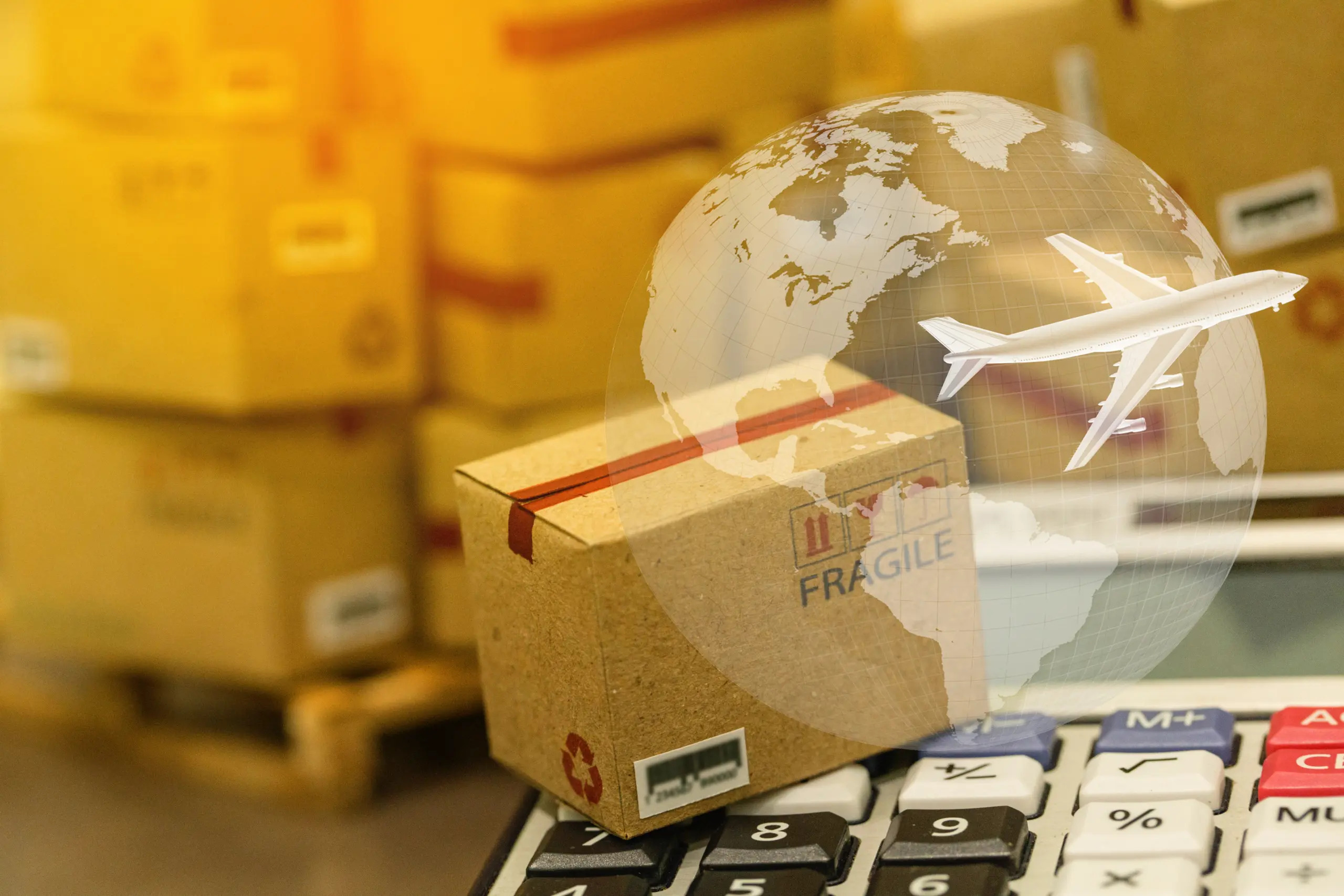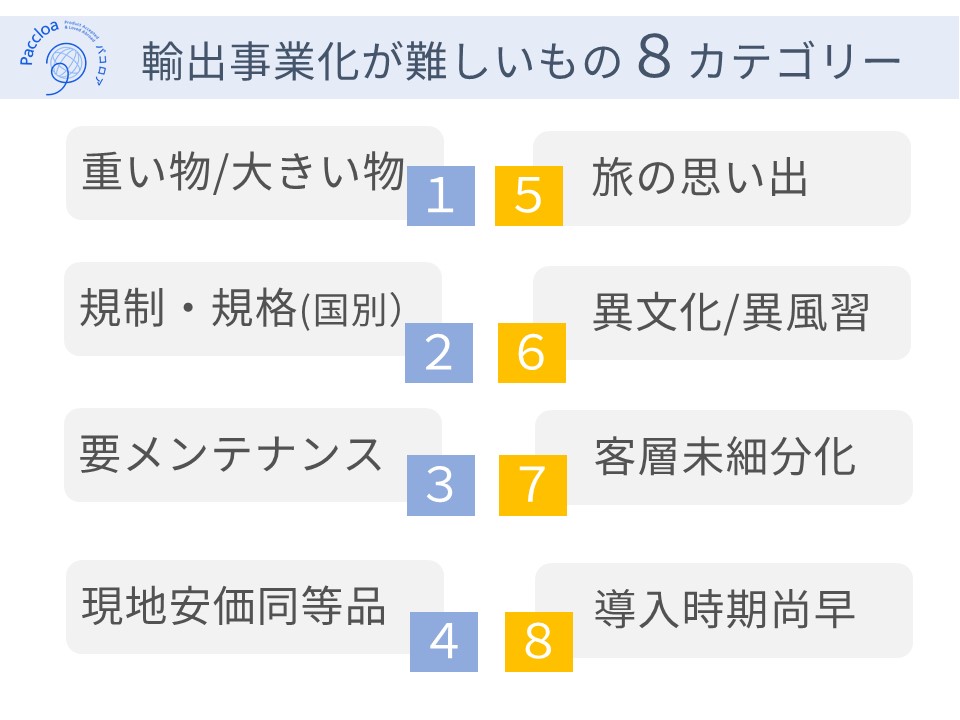Factors of failure in international expansion Hard to export (commercialize)
release 2020.09.19 update 2024.3.13
What do you mean by something that is hard to export (commercialize)?
It means that the product can be exported, but it is difficult to “make a profit from exporting”.
Ho, I would love to hear about it.
There are eight.

First, the premise is that you can export.
However, the reality is that some exports take time and money to make a profit or even to become profitable. If possible, it is better to know this information before starting to expand internationally, as a reference for building a strategy.
1.Heavy/Large objects
Shipping costs for large and heavy items are too high, so they will be less competitive than local alternatives. However,
- Functions and performance that cannot be replaced
- Something exceptional that is not available locally.
This is not the case if the
2.Country-specific regulations and standards
Each international country has import regulations.
It costs money to comply and to find out what the standard is.
Regulations are usually the law of the country and will not be ignored for export.
Do you know about import/export regulations/standards?
CE Marking…It’s not enough to say I didn’t know??
3.Maintenance required
When it comes to products that require maintenance, such as scissors and knives for barbers, tatami mats, and commercial water tanks, it is necessary to consider in advance how to incorporate maintenance services.
If you can build a great customer experience customer’s experience, you may not have to go through the hassle.
Customer’s Experience (CX) is the sensory and emotional added value, such as “comfort,” “surprise,” “excitement,” and “pride,” that customers experience during the pre- and post-purchase process and use of products and services. In addition to price and features, these superior customer experiences are becoming more important each year as reasons for repeat business.
4.Local low-cost equivalent
The product itself is good, but there are equivalent or similar products available locally, and many of them may not be able to beat the local price due to the cost of international shipping.
Hmmm…there are a lot of things going on.
We have machines, but is it difficult?
There are a number of businesses that have established exports, even for heavy machinery, device equipment that requires regular maintenance, etc.
If it is highly competitive, it will sell, don’t worry.
I see!
However, it seems like a handicap…
For the first four items, it is possible to build an advantage by switching to local production.
Oh, local production?
The difficulty level for the following 5 to 8 is even higher, as it is difficult to use the trump card of local production.
5.Travel memories
In the inbound market, there are probably many people who purchase a product in Japan because they think it is “wonderful” or “really useful,” but do not repeat the purchase until they import the product themselves.
This can also be turned into a pinch into an opportunity, depending on the customer’s experience that I mentioned earlier, and the ingenuity of the customer to have an emotional experience.
For example,
- Launching our own e-commerce site for international customers to make it easier for them to purchase.
- Continue to provide information that only the company can provide and that customers truly need.
- Organize workshops and offer special experiences.
- Planning products that cannot be obtained elsewhere and involving customers from the time of development
- build a relationship that cannot be replaced, which is what you get by continuing to buy.
and so on, and repeat orders will increase as brand loyalty grows.
6.Different cultures and customs
Many of the needs are subtle because of different cultural and customary backgrounds.
For example, Buddhist altars, kimonos, fans, snow shoes, Japanese accessories, parasols and masks, etc.
These will often leave out the cases where, for whatever reason, the item is “a must-have item that one would be willing to overcome different cultures and customs to obtain,” and will only be purchased from a minority who resonate with the beauty and story of a different culture in its own way.
It has been reported internationally that many people are reluctant to wear masks in the early stages of this coronary disaster.
It was an opportunity to understand that for some people with different cultures and customs, masks, for example, evoke images of crime and weakness, and that their sense of rejection and discomfort is not comparable to that of Japanese people.
In addition, if “cultural awareness” is required first in order to promote the product, be prepared for it to take time.
In the case of Kikkoman, for example, soy sauce is now called “KIKKOMAN” in the U.S., but it took about 40 years to penetrate the market.
Salonpas took more than 30 years to educate people in the U.S., where patch technology had not yet taken root, and has recently achieved the No. 1 share of the paste drug market in the U.S.
Products such as these, which are either not available in the country or are unfamiliar to the country and need to be educated from scratch, require both time and energy in the form of funds.
No matter how good the product is, it will have a long way to go before it takes root in international markets.
7.Customer segmentation
Japanese retailers are really segmented in terms of their target customers.
For example, Village Vanguard, Matsumoto Kiyoshi, and Don Quixote have different target customers. They are similar in some respects, but they are still different.
However, if the difference is needs, it would not be common for internationals to open multiple stores to meet those needs.
Since customer needs are not so finely divided, detailed product measures are unnecessary, and the question of who the product is for in the first place may bring the plan back to its starting point. This may lead the plan back to the starting point.
In the consideration stage of international expansion, it is often the case that even if a product is selling well in Japan, it may land in a country where the intended target audience may not be present.
This is because the Japanese market is very unique.
The phenomenon that if a product is popular in Tokyo, it will sell to some extent in Nagoya, Osaka, Fukuoka, and Sendai is less common overseas.
8.Premature introduction
There are countries where “manpower” is still cheaper than buying goods and services.
For example, when we conducted an F/S survey of a certain household product in India (a product that is sold very well in Japan and is always found in every household), we found that it was “definitely cheaper” to have a carpenter make a custom-made product than to buy the product in question.
(Three years later, the product is starting to sell in India.)
Even though we have a mission to “export durable products” to improve our customers’ problems = troublesome repairs, local people sometimes say that there is no need to buy Japanese products because “even if it breaks, replacements are cheaper” and “even if it breaks, the labor cost to repair it is even cheaper”.
However, it is often the case that the timing switches from such a situation where human labor is cheaper to one where it is more economical to buy something that lasts longer, or that the local situation changes in just 1-2 years.
When to start exporting will need to be carefully verified and considered.
People are cheaper than goods? I can’t imagine that in Japan.
Products 5. through 8. are also never unsuccessful.
However, it is a difficult category to sell, so careful planning is required in advance.
In fact, there are companies that have successfully commercialized the export of scissors, masks, tatami mats, kimonos, and even five-finger socks!
Behind the scenes, there is extraordinary effort.
By the way,
Without the influence of cultural customs,
If the product is also less regulated,
Does that mean that there is such an export advantage from the beginning?
That is correct!
I hope you can take advantage of those opportunities!

